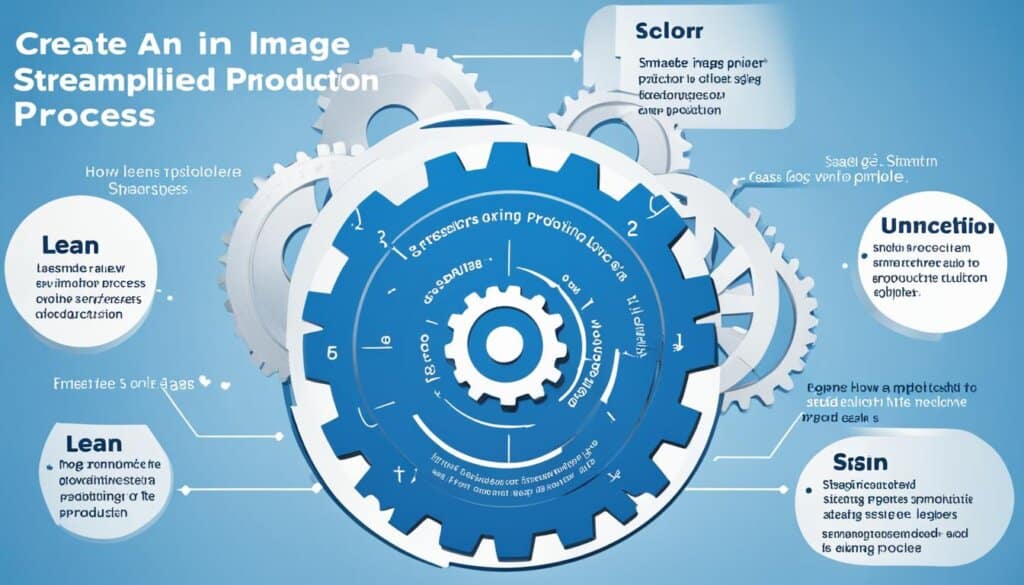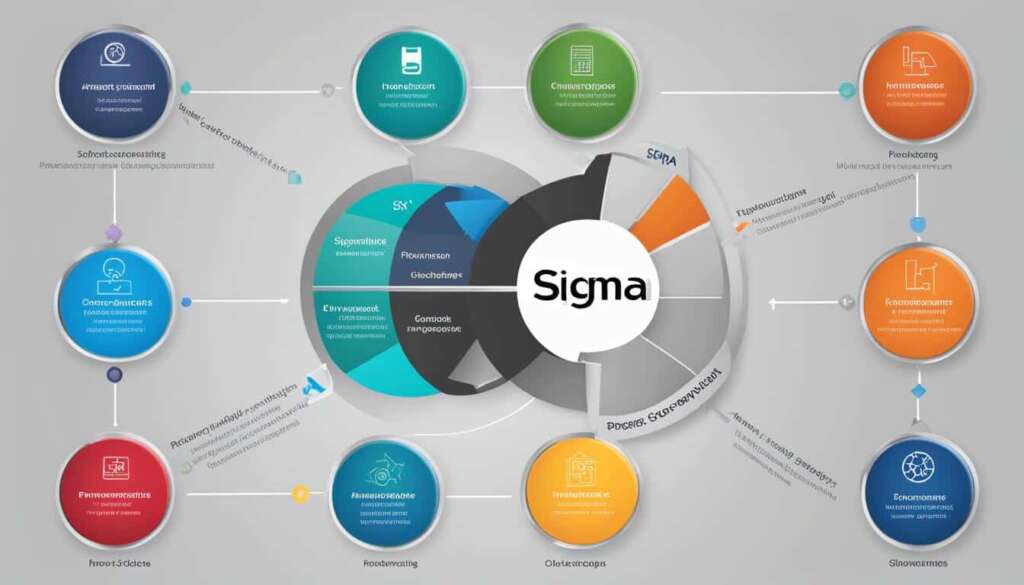Table of Contents
Six Sigma is a statistical measure that calculates how far a process deviates from perfection. Processes operating at six sigma have a failure rate of only 0.00034%, resulting in virtually no defects. Developed by Motorola in the 1980s, Six Sigma has been widely adopted by companies such as General Electric, Toyota, and Amazon. It is used in various industries, including manufacturing, healthcare, finance, and services, to improve customer satisfaction, reduce costs, and increase profits.
What is Six Sigma?
Six Sigma is a set of methodologies and tools used to improve business processes by reducing defects, minimizing variation, and increasing quality and efficiency. The goal of Six Sigma is to achieve a level of quality that results in only 3.4 defects per million opportunities.
This is accomplished through a structured approach called DMAIC (Define, Measure, Analyze, Improve, Control), which helps identify and eliminate causes of variation and improve processes.
What is Lean Six Sigma?
Lean Six Sigma is a powerful methodology that combines the principles of Lean and Six Sigma to drive process improvements and maximize efficiency. With its roots in manufacturing, Lean focuses on minimizing waste and eliminating non-value-adding activities, while Six Sigma employs statistical tools and techniques to reduce defects and improve quality.
By combining the strengths of both methodologies, Lean Six Sigma provides a comprehensive approach to process improvement that can be applied across various industries, including manufacturing, healthcare, finance, and services. Its main objective is to streamline processes, optimize resources, and enhance customer satisfaction.
Lean Six Sigma recognizes that waste can exist in various forms, such as extra processing, overproduction, waiting, defects, inventory, motion, and transportation. By identifying and eliminating these waste elements, organizations can achieve significant improvements in efficiency and reduce costs.
By employing Lean Six Sigma, companies can:
- Minimize waste and non-value-adding activities
- Maximize efficiency and productivity
- Streamline processes and reduce lead time
- Reduce defects and improve quality
- Optimize resources and reduce costs
- Enhance customer satisfaction and loyalty
To illustrate the power of Lean Six Sigma, consider the following example:
In a manufacturing company, the Lean Six Sigma team identified a process with excessive waiting time, defects, and rework. By applying Lean Six Sigma principles, they redesigned the process to eliminate non-value-adding activities, reduce variation, and implement error-proofing techniques. As a result, waiting time decreased by 60%, defect rate reduced by 75%, and production efficiency increased by 40%. These improvements not only reduced costs but also improved customer satisfaction and increased overall profitability.
Lean Six Sigma is a data-driven methodology that emphasizes the importance of thorough analysis and continuous improvement. Through the use of tools such as value stream mapping, root cause analysis, process mapping, and statistical analysis, organizations can uncover insights, make data-driven decisions, and implement sustainable improvements.
By adopting Lean Six Sigma, businesses can achieve a competitive advantage by improving their operational efficiency, reducing costs, and delivering superior value to their customers.

Lean Six Sigma Benefits
Implementing Lean Six Sigma can deliver a range of benefits to organizations, including:
| Benefits | Description |
|---|---|
| Improved efficiency | Streamlining processes and eliminating waste enhance efficiency and productivity. |
| Reduced defects | By focusing on quality improvement, organizations can minimize defects and improve customer satisfaction. |
| Optimized resource utilization | Lean Six Sigma helps identify areas of resource waste and reallocate them effectively. |
| Cost reduction | By eliminating waste, improving efficiency, and reducing defects, organizations can significantly reduce costs. |
| Enhanced customer satisfaction | Quality improvements and efficient processes lead to higher customer satisfaction and loyalty. |
The 5 Key Principles of Six Sigma
Six Sigma, a renowned methodology for process improvement, is built upon five key principles that drive its success. These principles guide organizations in delivering maximum benefit to their customers while continuously enhancing operational efficiency. Let’s explore these key principles in detail:
Focusing on the Customer
In order to achieve excellence, Six Sigma places a strong emphasis on understanding and meeting customer needs. By aligning processes with customer expectations and delivering superior value, organizations can enhance customer satisfaction and build lasting relationships. The customer is at the forefront of every decision and action taken within the organization.
Measuring the Value Stream
In Six Sigma, it is crucial to measure and analyze the value stream to identify areas of waste and areas that require improvement. By mapping the value stream and thoroughly analyzing the flow of activities, organizations can pinpoint inefficiencies, bottlenecks, and areas where value is not being added. This enables them to focus their efforts on the right areas to drive improvement and achieve optimal results.
Finding the Problem
A fundamental principle of Six Sigma is the relentless pursuit of identifying and solving problems. This involves a proactive approach of analyzing data, conducting root cause analysis, and applying problem-solving tools and techniques. By accurately identifying the underlying causes of problems, organizations can implement targeted solutions that address the root issues, leading to sustainable improvements.
Getting Rid of the Junk
In Six Sigma, eliminating non-value-adding activities and minimizing waste is of utmost importance. Organizations strive to streamline processes, remove unnecessary steps, and optimize resource allocation to enhance efficiency and productivity. By getting rid of the junk, organizations can focus their efforts on value-creating activities, resulting in improved process performance and resource utilization.
Keeping the Ball Rolling
Change is inevitable, and Six Sigma recognizes the importance of embracing continuous improvement. To keep the ball rolling, organizations need to establish a flexible and responsive ecosystem that welcomes change and adapts to evolving business needs. A culture of continuous improvement fosters innovation, drives efficiency gains, and helps organizations stay ahead in a dynamic marketplace.
“The journey of a thousand miles begins with a single step.” – Lao Tzu
Implementing the five key principles of Six Sigma requires dedicated efforts and a strong commitment to driving excellence. By focusing on the customer, measuring the value stream, finding and solving problems, eliminating waste, and fostering a culture of continuous improvement, organizations can unleash their full potential and achieve outstanding results.
| Key Principle | Description |
|---|---|
| Focusing on the Customer | Delivering maximum benefit and exceeding customer expectations |
| Measuring the Value Stream | Analyzing processes to identify waste and areas for improvement |
| Finding the Problem | Proactively identifying and addressing the root causes of issues |
| Getting Rid of the Junk | Eliminating non-value-adding activities and minimizing waste |
| Keeping the Ball Rolling | Establishing a flexible and responsive ecosystem that embraces change |
The Six Sigma Methodology
The Six Sigma methodology offers two main approaches to achieve process improvement: DMAIC and DMADV. Both methodologies are data-driven and emphasize root cause analysis to enhance project performance.
The DMAIC Methodology
The DMAIC (Define, Measure, Analyze, Improve, Control) methodology focuses on improving existing products or services. It provides a structured approach to identify and eliminate causes of variation, ensuring efficient process improvement.
“DMAIC is an invaluable tool for organizations looking to optimize their existing processes and deliver high-quality products and services.”
The DMAIC methodology involves the following phases:
- Define: Clearly define the project goals and deliverables, ensuring a clear understanding of the customer’s requirements.
- Measure: Collect data and measure the process performance using appropriate metrics to identify areas for improvement.
- Analyze: Analyze the data and identify the root causes of defects or process inefficiencies. Conduct a thorough root cause analysis to address the underlying issues.
- Improve: Implement process improvements based on the analysis, focusing on reducing defects, minimizing variation, and enhancing efficiency.
- Control: Establish control measures to sustain the improvements achieved and monitor the process to ensure consistent performance over time.
By following the DMAIC methodology, organizations can systematically improve their existing products or services, resulting in enhanced quality, reduced costs, and increased customer satisfaction.
The DMADV Methodology
The DMADV (Define, Measure, Analyze, Design, Validate) methodology, also known as the DFSS (Design for Six Sigma), is used to design or re-design processes for new products or services. It provides a structured approach to ensure the development of efficient and effective processes.
“DMADV enables organizations to design innovative processes and deliver new products or services with superior performance and quality.”
The DMADV methodology involves the following phases:
- Define: Clearly define the project goals and customer requirements, understanding the desired outcomes for the new process.
- Measure: Identify and measure critical parameters related to the process performance and establish suitable metrics for evaluation.
- Analyze: Analyze the data and identify potential design concepts that meet customer requirements while minimizing risks and maximizing performance.
- Design: Develop and design the new process based on the analysis, incorporating the identified design concepts and optimizing resource utilization.
- Validate: Validate the designed process through simulations, prototypes, or pilot studies, ensuring its effectiveness and performance before full-scale implementation.
By applying the DMADV methodology, organizations can create new processes that meet customer expectations, improve project performance, and deliver innovative products or services.
The Six Sigma methodologies, DMAIC and DMADV, offer structured approaches for data-driven process improvement, whether it is enhancing existing products or services or designing new processes. These methodologies provide organizations with the tools and techniques to achieve optimal performance, reduce defects, and ensure continuous improvement.
The Six Sigma Process of Business Transformation
The DMAIC method is the standard process used by Six Sigma practitioners to optimize and improve business processes. It consists of five phases: Define, Measure, Analyze, Improve, and Control. Each phase has specific steps and activities, emphasizing a data-driven approach and a customer-centric focus.
- Define: In this phase, project goals and customer requirements are clearly defined. The team identifies the process that needs improvement and sets measurable objectives.
- Measure: This phase involves gathering data related to the process and identifying key metrics for measuring performance. The team uses statistical tools to establish a baseline and determine the current state of the process.
- Analyze: During this phase, the team analyzes the collected data to identify root causes of defects and variations in the process. Various tools and techniques such as root cause analysis and hypothesis testing are used to gain insights.
- Improve: In this phase, the team develops and implements solutions to address the identified issues and improve the process. The focus is on reducing defects, eliminating waste, and optimizing resources.
- Control: The final phase ensures that the improvements made are sustained and the process remains in control. Control plans are developed, and monitoring mechanisms are put in place to measure performance, identify any deviations, and take corrective actions.
“The DMAIC method provides a structured and data-driven approach to identify and address process inefficiencies, ultimately leading to improved quality, customer satisfaction, and business performance.”
The underlying framework of Six Sigma, including the DMAIC method, underscores the importance of measuring, analyzing, and improving processes in a structured manner. The methodology is data-driven, enabling businesses to make informed decisions based on objective evidence. By adopting Six Sigma, organizations can optimize their operations, reduce defects, enhance customer satisfaction, and achieve sustainable business transformation.
What is the difference between Six Sigma vs. Lean Six Sigma?
Six Sigma and Lean Six Sigma are two distinct methodologies that aim to optimize business processes and improve overall performance. While they share similarities, there are key differences that set them apart.
Six Sigma: Focusing on Quality Management
Six Sigma is primarily focused on quality management and reducing variations in processes. Its main goal is to limit fluctuations and defects, leading to improved customer satisfaction and increased profitability.
By using statistical analysis and data-driven approaches, Six Sigma helps organizations identify and address root causes of inefficiencies, leading to enhanced process performance and quality control.
Lean Six Sigma: Streamlining Processes and Decreasing Waste
Lean Six Sigma, on the other hand, combines the principles of Six Sigma with Lean methodologies. The primary focus of Lean Six Sigma is to eliminate waste and optimize processes to maximize efficiency.
Lean principles aim to identify and eliminate non-value-added activities, reducing lead times, and increasing productivity. By integrating Lean and Six Sigma, organizations can achieve significant improvements in quality, cost reduction, and customer satisfaction.
While Six Sigma emphasizes quality management and reducing variations, Lean Six Sigma takes a broader approach by also targeting waste reduction and process optimization. Both methodologies have their strengths and can be applied in various industries to achieve operational excellence.
How to Implement Six Sigma
Implementing Six Sigma requires careful planning and execution to ensure its successful integration into an organization’s processes. The first step is to obtain stakeholder buy-in and set clear expectations. By involving key stakeholders from the beginning, you can gather support and align everyone towards the common goal of process improvement.
Project management plays a crucial role in implementing Six Sigma. It involves creating a structured framework to guide the entire process, from defining the project scope to monitoring the progress and ensuring timely completion. By establishing clear project goals, milestones, and responsibilities, project management helps keep the implementation on track.
Proper allocation of resources is essential for the success of any Six Sigma initiative. This includes providing the necessary tools, equipment, and skilled personnel to carry out the improvement projects effectively. Additionally, it is vital to educate team members on the principles and methodologies of Six Sigma, enabling them to actively contribute to the process improvement efforts.
A quality control chart and a measurement system are crucial components of Six Sigma implementation. These tools allow you to monitor and measure process performance, identify variations, and track progress over time. Root cause analysis helps delve deeper into the underlying causes of process inefficiencies or defects, enabling you to address the root causes rather than just treating the symptoms.
Continuous improvement is at the heart of Six Sigma. As you implement Six Sigma, it is crucial to establish a culture of continuous improvement, where all team members are encouraged to propose and implement process enhancements. Regular reviews, feedback loops, and data-driven decision-making enable ongoing optimization and refinement of processes.
By following these steps and tailoring them to your specific implementation approach, you can effectively implement Six Sigma and achieve significant improvements in process efficiency, quality, and customer satisfaction.
FAQ
What is Six Sigma?
Six Sigma is a statistical measure that calculates how far a process deviates from perfection. Processes operating at six sigma have a failure rate of only 0.00034%, resulting in virtually no defects. It is used to improve customer satisfaction, reduce costs, and increase profits in various industries.
What is Lean Six Sigma?
Lean Six Sigma is a methodology that combines the principles of Lean and Six Sigma. It aims to minimize waste, maximize efficiency, reduce defects, and improve quality in any industry, including manufacturing, healthcare, finance, and services.
What are the key principles of Six Sigma?
The key principles of Six Sigma include focusing on the customer, measuring the value stream, eliminating non-value-adding activities, involving all stakeholders, and establishing a flexible and responsive ecosystem.
What are the main methodologies of Six Sigma?
The main methodologies of Six Sigma are DMAIC and DMADV. DMAIC is used to improve existing products or services, while DMADV is used to design or re-design processes for new products or services.
What is the Six Sigma process of business transformation?
The Six Sigma process of business transformation follows the DMAIC method, which consists of five phases: Define, Measure, Analyze, Improve, and Control. It is a data-driven approach that focuses on optimizing and improving business processes.
What is the difference between Six Sigma and Lean Six Sigma?
Six Sigma aims to improve quality management and reduce fluctuations in business processes, while Lean Six Sigma focuses on eliminating waste and improving existing processes. Both methodologies have their strengths and can be applied in various industries.
How do I implement Six Sigma?
Implementing Six Sigma requires obtaining stakeholder buy-in and setting clear expectations. Steps include highlighting quality losses, implementing project management, providing necessary resources, educating team members, and conducting root cause analysis.













